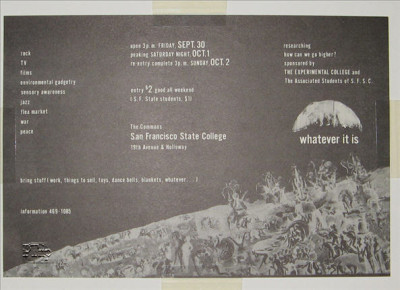whatever it is festival @ sf state, 30 September-2 October 1966.
What you’re looking at now is a sunshine grass dance. Anyone knows what that is.
What are extra-sensory…? No.
— Art Brown, tv reporter
Handbill for the Whatever It Is Festival, SF State College, 1966.
The wonderful digital collection from the San Francisco Bay Area Television Archive features a little glimpse of the afternoon fun at the Whatever It Is Festival held at the Experimental College of San Francisco State University (then College). “Researching how can we go higher?” was the Festival’s slogan. It was organized by Stewart Brand, appearing in Prankster garb in the footage, and students at SF State.
The closing night featured an Acid Test, with a disguised Ken Kesey (just back from fugitive adventures in Mexico), the Grateful Dead, Wavy Gravy, and others. Memories of the evening from various participants suggest a chaotic, fun, avant-garde continuation of the Acid Test energies first unleashed in the fall of 1965. One year later, things continued to go more public, pulling in college students especially.
Mostly, though, in the footage, we see awkward but sweet dancers, balloons, and a little-known Bay Area rock band, Daemon Lover. And maybe that is among the best visions of the SF counterculture: people coming out into the sunshine, feeling their privilege, but also, in the same move, their willingness to explore ways of dancing self and society into dynamics beyond the existing order of things.
Handbill for Whatever It Is Festival, SF State College, 1966.
This is the event at which Kesey, Wavy Gravy, Jerry Garcia, and others holed up in a small room (possibly the student radio station?) near the cafeteria in which the event was held and riffed on the event as it was unfolding. Garcia plays organ on the recording. The “tarnished Galahad” Kesey is at his best here, rapping imaginative flights of social commentary. A “nirvana army” was what he thought the rock music counterculture could become at the event, and beyond it—if they could only figure out where they were marching to, what they were marching for, and in what formation.



electricity is coming next week; didn’t forget
harry
in answer to your twitter post:
Owsley spoke of one of his more memorable brushes with synesthesia during an Acid Test in Los Angeles.
“In L.A., I saw sound coming out of the speakers. One dose of acid, some DMT, and something else, and I thought, “This is important. I’ve got to remember what this is about.” I studied it very intently, which was difficult to do when you were that high. I thought, “This is not what I expected sound to look like.” I never assumed it was some hallucination caused by the drug. The circuits were open full-on. It was real.”
Owsley’s experience seeing sound had a profound effect on his understanding of the phenomenon. He was to incorporate the knowledge he gained into the sound systems he was later to design and operate for rock groups, particularly the Grateful Dead.
“I think my knowledge of the true nature of sound dates back to the period of the L.A. Acid Tests and specifically, one of the rehearsals we had in the house in Watts when I actually saw sound coming out of the speakers. . .It was just a unique experience. And it so completely blew my mind, that I realized, “Hey, no matter what, I’ve got to remember what this [the sound] is doing. I went around and inspected it very carefully, and I spent a lot of time absorbing what it was doing and realizing how different it was from what I thought sound did. And that became the foundation for all the sound work that I’ve done. The fact that I was able to convert aural information into a three-dimensional image – it was all coming from my ears, of course, but transforming it into a visual form.”